An Introduction to the World of Ecosystem
Our traditional concept of an ecosystem relates to that of a physical one – out there somewhere in the wild. And this is not wrong. An ecosystem really is, simply put, something within which organisms interact with each other.
“The Future of the World is in My Classroom Today.“- Ivan Walter Fitzwater
An example is a tidal pool on the South African coast. Or another is the Amazon rainforest of South America. Despite being very different in size, both are examples of ecosystems – multiple organisms living together in combination with their physical environment.
And these ecosystems can be extremely diverse. Some ecosystems are an ocean, others freshwater, and others are terrestrial, or land-based. Ocean ecosystems are the most common, covering 75% of the earth’s surface. Freshwater ecosystems are the rarest, covering only 1.8% of the earth’s surface. Terrestrial ecosystems cover the rest.
Terrestrial ecosystems can be grouped into categories called biomes, based largely on climate. Examples of terrestrial biomes include tropical rain forests, savannas, deserts, coniferous forests, deciduous forests, and tundra.
But there are also other kinds of ecosystems. In fact, the term is increasingly used to illustrate the environment within which people operate as part of a system. There are Business ecosystems. Industry ecosystems. Supplier-and-customer ecosystems. Political ecosystems. The list goes on.
For our purposes, we are especially interested in exploring the concept of an Educational Ecosystem.
Children operate, amongst others, within a School Ecosystem. This ecosystem is characterized by the buildings which house them, the teachers, other staff, and the interactions which take place daily between the children and teachers.
The school in turn is part of a larger ecosystem. In fact, it is part of several ecosystems. Firstly,
it forms part of the Educational Ecosystem, with many role-players involved from national, to
provincial, to the local level.
But it is also part of the Community Ecosystem, characterized by the local community, parents,
school governing bodies, and other stakeholders. It is of course also part of another ecosystem,
i.e. the Home Environment. A schematic portrayal of this “Child Ecosystem” may be found in
figure 1.
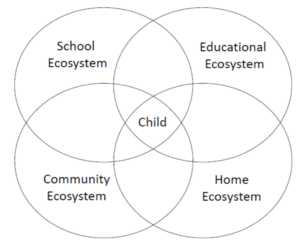
So, the concept of an ecosystem is as wide or as narrow as you would like it to be, but the point is – we are all part of an ecosystem, and generally part of many ecosystems.
These ecosystems are characterized by numerous explicit and implicit rules and norms that dictate how the “organisms” within them should interact with each other, and with their environment.
In a very subtle way, our children are exposed to these ecosystems from the moment that they are born – first within the home only, then the preschool, then primary school, then secondary school, and so on.
Simultaneously they are also exposed to other ecosystems that run in parallel to their child ecosystem, e.g. the community ecosystem, the friendship ecosystem, the religious ecosystem, the sporting ecosystem, the relationships-in-general ecosystem, etc.
Therefore, as the child grows and becomes more and more aware of the various ecosystems (seldom termed such, of course) and of the variables within these systems that have a push and pull influence on his or her life, it becomes increasingly challenging for the child to find his way among this myriad of sometimes contradictory influences.
It is important that parents and teachers understand this, so that they may be able to guide the child properly through especially the early years of their lives, which may at times be very confusing.
Aim
The aim of this article is to elaborate on the concept of an educational ecosystem to provide especially preschool teachers with some sort of roadmap to guide their curricular activities at school.
Three types of ecosystems are discussed:
1) The childcare/teaching ecosystem.
2) Examples of getting children involved in understanding the functioning of natural ecosystems – also termed the micro-ecosystem.
3) The macro ecosystem for teachers, principals, and parents to help them strategize for a better teaching environment.
The Childcare/Teaching Ecosystem
Providing a safe and nurturing environment is part of supporting the learning and development of infants, toddlers, and preschoolers.
Unfortunately, many ECD practitioners are unsure how to create environments that support their children’s learning across different age groups and developmental domains (e.g. the ELDAs3).
Well-designed classroom environments:
- Encourage appropriate social interactions among children.
- Encourage feelings of competence in young children.
- Provide structure and predictability.
- Promote children’s engagement.
- Support responsive caregiving.
- Decrease errant behavior.
- Encourage staff efficiency.
The specific childhood ecosystem consists of three interdependent components, as illustrated in Table 1:
Table 1: Interdependent Components of an Early Childhood Ecosystem
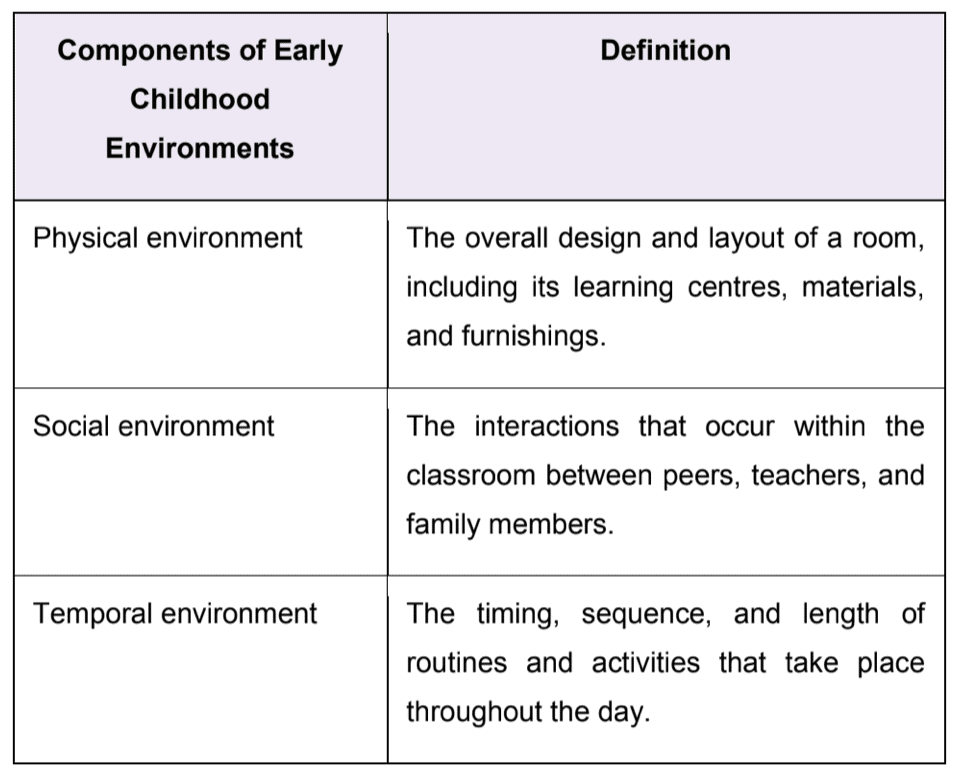
These three components must be carefully designed and implemented for maximum involvement of children in the various age groups.
Every aspect of a classroom’s design should reflect the specific learning program, or framework’s, priorities, and philosophy.
For example, a framework that concentrates on improving children’s math skills is likely to emphasize the availability of materials related to numeracy, as well as to learning shapes and patterns.
If the framework’s philosophy is not ELDA-based, but say based on Montessori, which emphasizes hands-on work with materials, one might expect to see beads or Lego blocks to support the teaching of mathematical concepts.
A Micro Ecosystem – Getting Children Involved
One of the first things to teach children is that everything in an ecosystem is related to each other in some way or another, and that matter is recycled through the earth’s ecosystems – though it may move from one ecosystem to another.
To illustrate this by means of an example from a micro-ecosystem within the natural environment – see Figure 1. Here we note that the insects, trees, plants, animals all have some sort of recycling interaction – the one is eaten by the other and/or becomes compost which is used as fuel by plants.
Figure 1: A Micro Ecosystem in Nature
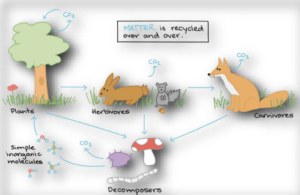
When animals carry out respiration, carbon dioxide is released into the atmosphere. This in turn is absorbed by plants.
Similarly, when they excrete waste or die, their chemical compounds are used for energy and building material by bacteria and fungi.
To get children thinking more about how ecosystems work, you could ask them to imagine a day in the life of an animal.
What do they eat?
Where do those plants or animals get their energy?
What kinds of predators do they need to watch out for?
Getting children to think about the natural environment that surrounds them is a great first step in helping them understand how ecosystems work.
However, sometimes it’s impossible to venture outside, and it’s also important for kids to consider ecosystems other than their own.
This simple activity introduces kids to food chains using the example of a forest ecosystem with different species of plants and animals.
They will come to understand that every species is essential for an ecosystem to stay healthy, no matter how big or small (this is more suited to older children, but teachers can use a simple variation on this theme for younger children).
Building an Ecosystem in a Bottle. Ecosystems are more than food chains or food webs.
For children to really understand how ecosystems work, it’s important for them to realize that energy and moisture cycle through ecosystems in ways that we may not be able to immediately see.
One of the best ways for them to learn about these key elements of ecosystems is through building a self-sustaining ecosystem in a bottle. There are many different ways to build bottle ecosystems.
The simplest ones are basically closed terrariums, consisting of plants, either land-based or aquatic, and a bit of rich soil, compost, or pond water.
Others, built from soda bottles, combine aquatic and land-based life forms.
On the bottom level place some rocks, pond water, and maybe a few marine invertebrates such as shrimp or snails.
A lot of planning goes into building a bottle ecosystem, but you can easily make that planning a learning process by putting some of it in the hands of the children.
Make sure that you keep the difficult and potentially dangerous tasks, like cutting with a pair of scissors, to yourself.
Children should be encouraged to draw their own, gradual conclusions about why their ecosystem is struggling, or how the plants and animals continue to survive.
No matter how simple your experiment is, it will encourage children to start grasping how everything in nature truly is interconnected, and they will be full of questions about what links different kinds of creatures together, and how changes to one element can affect the ecosystem as a whole.
The Macro Ecosystem – The Importance of Strategizing
In Figure 1 we illustrated that the child “lives” in the center of an ecosystem which, especially during his or her formative years, is relatively narrow, characterized by only a limited number of role-players. Or at least that the child is aware of.
But it is of course true that the same child lives within a much bigger ecosystem, which he or she only gradually becomes aware of as they grow older.
It is incumbent upon the teacher to understand, right from the get-go, the size and impact of this bigger ecosystem. Figure 2 illustrates how this “macro ecosystem” looks.
Figure 2: The Macro Ecosystem
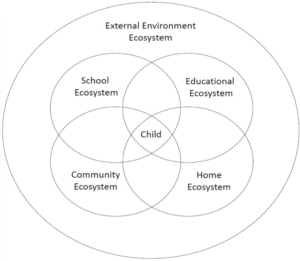
The External Environment surrounds the smaller “micro” ecosystem within which the child lives.
The child is largely oblivious to this, but for the school, in its efforts to strategize as to how it wants to position itself for the future, and how it wants to develop as an institution, it is essential to understand the dimensions of this external environment, because they have a fundamental impact on how the school needs to position itself for the future.
In Figure 3 we have further broken down this macro ecosystem into its various elements – the Internal Environment, and then the External Environment, which in turn is broken down into Specific Environment and General Environment.
Figure 3: Ecosystem Broken Down into its Constituent Elements
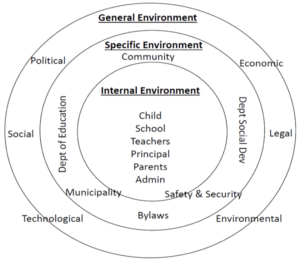
We have listed some of the variables, or factors, to be found within each of these environments. There may be many more. For the school, it is however important to understand how these various environments (ecosystems) and factors influence each other, especially when it comes to strategizing for the medium to long term.
Typically, some of the strategic issues that a school will struggle with when it starts its annual planning cycle are the following:
- Expansion (or contraction) of the number of enrolled children.
- Better school/parent communications.
- New extracurricular activities.
- New building plans.
- New regulations from the Department of Education may have an impact on the school.
- New health and safety regulations and their financial/human impact.
- Security issues.
- Introducing new curricula.
- Contraction in parents’ spending power due to problems in the economy at large.
- The potential impact of 4IR (4th Industrial Revolution) on training curricula and teachers.
- The developments in the field of STEM (Science, Technology, Engineering, and Mathematics).
- Quicker response times for matters that are important to parents.
- New feeding schemes and menus.
There are likely to be many other factors that may be relevant. Point is – it should be evident that most of these can be related to some of the factors listed within the Figure 3 macro ecosystem.
It is, therefore, incumbent upon all the stakeholders in the school to understand exactly what these factors are, and to then make certain strategic assumptions about each of them. The way to go about it is illustrated in Table 2.
Table 2: Strategic Assumptions Formulation Example
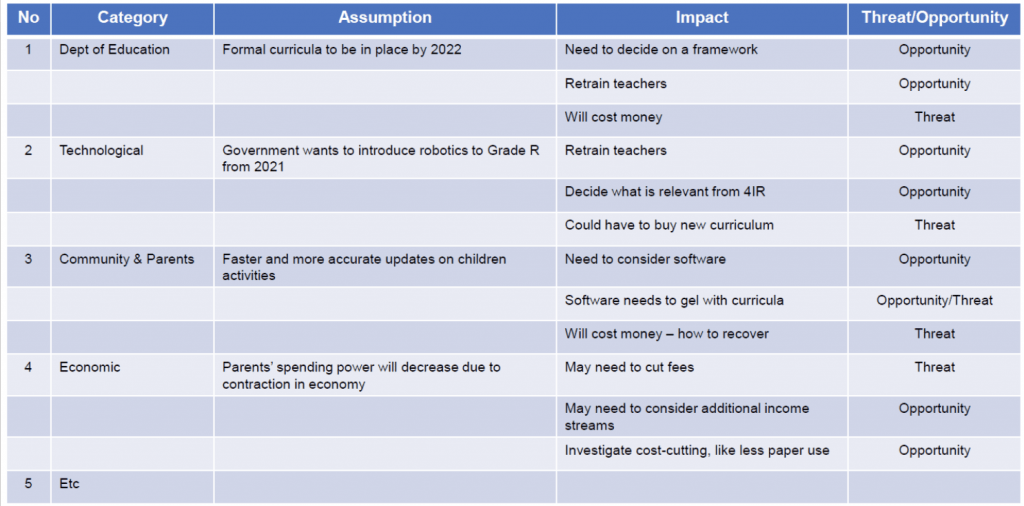
Such an exercise will set a useful benchmark for discussion and strategizing. This is of course only one of the useful tools for strategizing within the school environment. Another article will deal with the Teaching Recycling subject in much more detail…
Conclusion
The World of Ecosystem(s) is a complex one, but one from which we cannot disassociate ourselves.
It is important for children to understand this at a micro level, and for teachers and other role-players in the child’s development, to understand it at a macro level.
At a micro-level, we have shown how a child’s perceptions may be formed by specifics related to its physical, social, and temporal environments. It is also important for the child to indeed understand how the nature ecosystem’s functions, even though he/she may not yet understand what his or her specific role is within the ecosystem within which they live.
This will become clear to them over time and needs to be carefully nurtured and developed by teachers.
At a macro level, teachers and other role-players within the educational environment need to understand the ecosystem within which they operate, so as to be able to properly strategize for ensuring that their school, and the children, are optimally positioned for the future integrated environment, as members of a society that comprises multiple overlapping systems.
References
http://www.personal.psu.edu/wxh139/System_Talk.htm
Iris Center. Early Childhood Environments.
https://iris.peabody.vanderbilt.edu/module/env/cresource/q1/p01/ (accessed on 16 February 2020).
Khan Academy. What is an Ecosystem?
https://www.khanacademy.org/science/biology/ecology/intro-to-ecosystems/a/what-is-an-ecosystem (accessed on 17 February 2020).
Ledo. What is Education Ecosystem? https://education-ecosystem.zendesk.com/hc/en-us/articles/360004261692-What-is-Education-Ecosystem- (accessed on 16 February 2020).
Oliver, G. Education and the Educational Ecosystem.
https://whatiseducationhq.com/articles/education-for-good-living/ (accessed on 17 February 2020).
Project Learning Tree. Hands-on Activities for Introducing Ecosystems to Elementary Students. https://www.plt.org/educator-tips/ecosystem-activities-elementary-students (accessed on 16 February 2020).
Van Vuuren, I. Strategy as Art and Science: A Framework for Planning. 2018. Doha, Qatar.